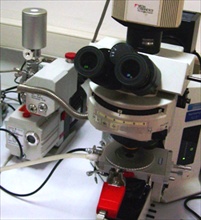Members Login

Channels
Special Offers & Promotions
Linkam Scientific temperature controlled THMS350V heating vacuum stage is used to examine atmospheric and vacuum frying of starch granules in oil and water.
 Market leaders in temperature controlled
microscopy, Linkam Scientific Instruments, have been chosen by Pontificia
Universidad Católica de Chile to supply a THMS350V stage to understand the
frying of starch in oil and water.
Market leaders in temperature controlled
microscopy, Linkam Scientific Instruments, have been chosen by Pontificia
Universidad Católica de Chile to supply a THMS350V stage to understand the
frying of starch in oil and water. At the Pontificia Universidad Católica de Chile, a research team headed by Pedro Bouchon PhD in the Chemical and Bioprocess Engineering Department are using a Linkam THMS350V stage to examine atmospheric and vacuum frying miniaturization of starch granules in oil and water. The chemical and structural aspects of vacuum frying are still not very well understood and so further experimentation is required to understand the process. The goal of the group is to understand the role of different ingredients when they are processed under different conditions, studying the effect on micro and macro-structural properties, functionality, and the impact that these processed ingredients have on nutrition. The aim is to design and develop, based on scientific knowledge, new food matrices that fit new consumer demands for healthier, low fat snack products that also taste as good as the traditional ones.
The group are comparing the effect of vacuum and atmospheric frying using real-time hot-vacuum-stage microscopy. Isolated starch granules are examined for micro-structural changes during vacuum and heating in both oil and water. The Linkam THMS350V is mounted on an Olympus BX-61 light microscope and the samples are tested at different heating rates with different vacuum levels. Samples are totally immersed before frying, and real-time image capture is used to examine structural changes.
Micro-structural changes are indicated by swelling and gelatinization of the potato starch granules during heating at 15°C/min at atmospheric pressure. Granules start to swell at 64°C. As the temperature increases the granules start to lose their shape and at 100°C the granules begin to dehydrate due to water evaporation. The loss of birefringence of the granules indicates the onset of the gelatinization process.
Pablo Cortes, a member of Pedro Bouchon's group, described how the Linkam stage has "allowed us to understand the development of the microstructure of potato starch granules in different conditions in real time. We have studied the gelatinization process of isolated potato starch granules heated in excess water and embedded in a gluten and water matrix. This micro-structural approach has given us information of paramount importance to understand the frying and vacuum frying process."
Heating-vacuum microscopy is an essential technique to begin to understand the complex process of vacuum frying which may lead to innovative ways to prepare our food.
Visit Linkam at http://www.linkam.co.uk/ and learn about the broad range of applications in the field of temperature controlled microscopy.
Media Partners


